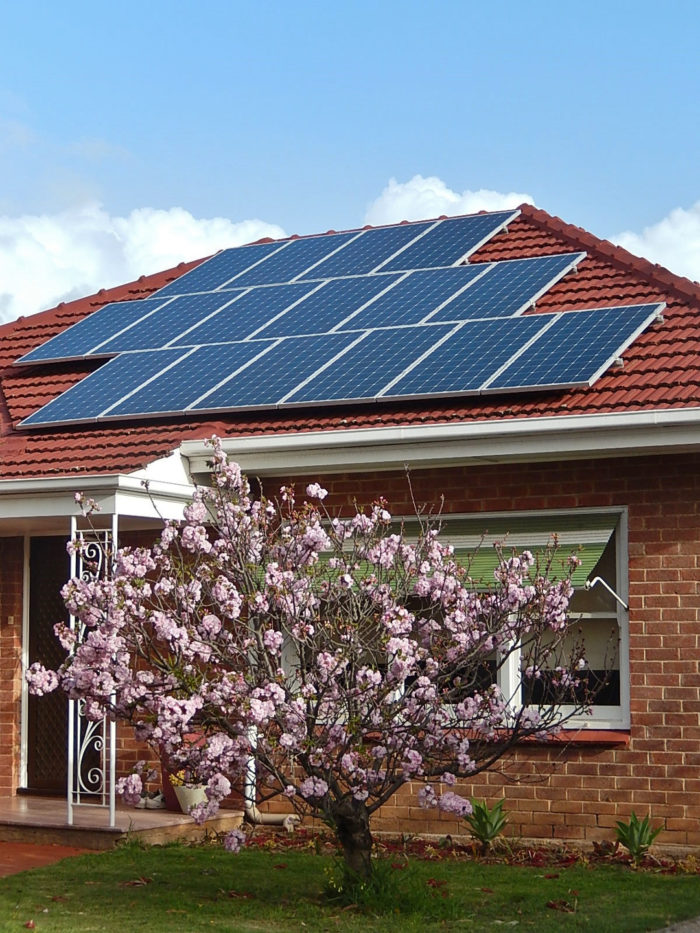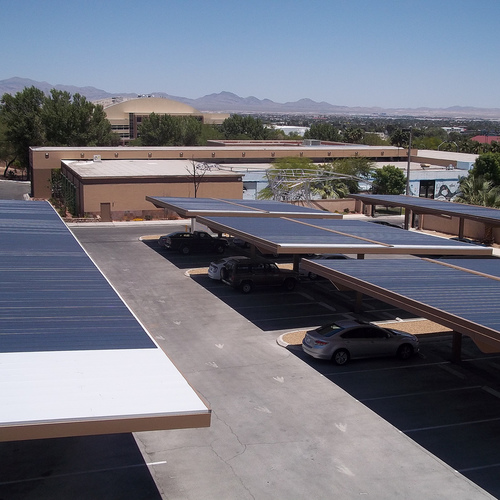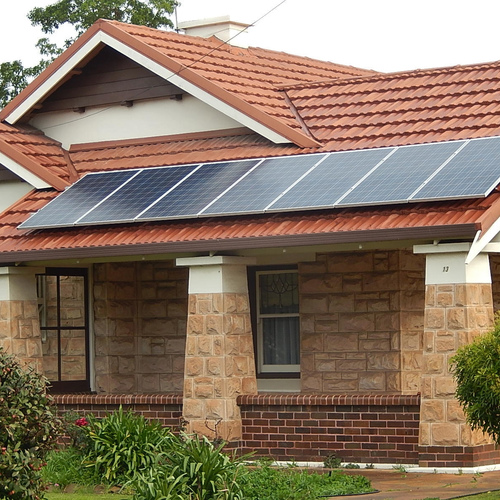
Image Credit: Michael Coghlan via Flickr
The U.S. isn’t the only place where consumers are closely watching the solar panel market and wondering when the cost of electricity derived from photovoltaic (PV) panels on their rooftops will be the same as or lower than what they’d pay for power from a utility.
In Australia, a report from Bloomberg New Energy Finance says that consumers already can install solar panels and battery storage to provide electricity for less than grid rates, and that the adoption of these twin technologies probably is “unstoppable.”
The prediction was posted at One Step Off the Grid, a new spinoff website developed by RenewEconomy to cover the consumer side of the energy market there.
In a post July 21, Giles Parkinson wrote that even if retail electricity prices remained flat, “rooftop solar PV can already provide power to consumers in homes at well below the price of [grid-supplied] electricity.”
Bloomberg reports the price of PV electricity, with no battery storage, is lower than retail electricity, and well below the cost of grid power when the systems have batteries of either 1 kW or 3 kW. Prices appear about the same now when a 5 kW battery is included in the system, but all of those PV-plus-battery options are well below retail rates in projections going out to 2030.
Similar issues confront the Aussies
Australian consumers and utilities seem to be facing many of the same challenges as their counterparts in the U.S. As prices for PV modules and battery storage fall, the systems grow ever more attractive for homeowners, putting more pressure on utilities to adapt their business models in response.
“Storage technologies as well as PV will be able to provide costumers with electricity at a cheaper cost than the grid,” Bloomberg’s Kobad Bhavnagri says. “And as storage gets cheaper even larger amounts of storage will be able to supply consumers at a cheaper cost to the grid. On economic fundamentals this technology is unstoppable.”
Bhavnagri and others believe 50% of all electricity will be supplied by sources “behind the meter” by 2040, Parkinson writes, but he sees a continuing role for the grid.
“We will still need the grid for different purposes,” Bhavnagri writes, but inevitable changes in the way utilities operate will almost certainly mean a write-down in their value.
“The business model of the networks has to change,” Bhavnagri told Bloomberg. “They have got to sell services instead of kilowatt-hours. Much of what they built is redundant, resulting in excess capacity, and networks are overcharging and not delivering a commodity or service that is valuable to consumers.”
That sentiment is shared by many renewable energy advocates in the U.S. Utilities here have responded to pressure from the growth of residential solar in a variety of ways. A number of them have sought surcharges on solar customers to offset lower sales, but the issue is handled differently from state to state.
Weekly Newsletter
Get building science and energy efficiency advice, plus special offers, in your inbox.















5 Comments
Australia is the future
The Australians are the people to watch as they have a perfect soup of conditions for the emergence of PV and storage. They have the sun, they have ridiculously overpriced grid prices, they have the best installation prices of PV in the world, and they are now being flooded with home battery storage at excellent prices. They also, thanks to people like Giles Parkinson, who is a green journalist, have sensible evaluations of how much, exactly, batteries cost per kwh and how much Pv costs per kwh and how much a house can expect to use and in what proportion between direct solar and solar plus storage. This is the information people actually require to make a sensible decision about how to power their houses.
The Australian are at an advantage, not unlike the southern U.S. for solar since PV produces just when you need it for Air Con, whereas in the Northern U.S., PV is weakest just when you need it, for heat.
Peak grid loads in the southern US (response to ven)
It's a bit ironic, but the annual peak grid loads in places like GA & FL occur in the dark nighttime hours on the coldest nights of winter. The is due to the large numbers of houses & buildings using heat pumps or air conditioners outfitted with resistant heating strips for auxilliary, or heated with electric baseboards or similar as the primary space heating. PV is great for cutting air conditioning peaks, but doesn't impact those space heating peak loads.
Conversely, in the northern US the much higher heating energy needs make resistance heating too expensive, and it is rarely used The annual grid load peaks in the north are highly correlated with peak summertime air-conditioning loads (just as they are in California.)
In Australia electric rates are too high to make resistance heating attractive even in milder areas, and annual grid load peaks are also correlated with air conditioning loads. Heat pumps ( called "reverse air conditioners" in Aussie dialect) are popular options for space heating, since even the colder parts of Australia are warm enough in winter to get reasonable performance out of them. If Southern US electricity prices tripled to match those in Australia, you can bet that nobody would be installing central air with resistance heating strips for space heating, as is common today.
At the moment PV + battery is becoming economically rational against retail grid pricing in Australia, but it'll be at least a decade before that's the case in the southern US. The financial crossover point will happen much sooner in the northeastern US, where retail grid pricing is in the 20 cents/kwh range, but as long as there is net metering or other reasonable compensation for grid-attached PV (unlike the Australian model that gouges & penalizes PV owners once the feed in tariffs expire, or even before), there won't be a lot of outright grid defection.
Peak grid loads in the Southern U.S.
Even all the way up in Virginia, our peak is now in the winter (as of 2015)....though the peaks actually happen just after people start to get up and take showers...typically ~7am to 8am. Lots of electric resistance space heating still going on since the sun hasn't come up (supplemental heat for heat pumps as well as baseboard) AND electric resistance water heaters AND coffee pots, toasters, microwaves, stovetops, etc.
Of course, our summer peaks are about 99% as high as the winter peaks, so we really give it to the grid (take from the grid?) coming and going.
The AM crunch time. (response to John Semmelhack #3)
I would imagine that those using overnight setbacks and resistance heating would still be coming up to temp while cooking. The peak heating load is typically just before dawn, but the peak grid load probably precedes that by an hour or two since people are getting up before then, and ovenight setbacks are stepping back up.
Using modulating heating/cooling and a "set & forget" approach to temperature would moderate both the summertime and wintertime peak grid loads, but until & unless folks get compensated in some way for doing that, it's not going to happen. The traditional utility business model incentivizes infrastructure investments, not capacity savings or energy savings, so for those utilities there is more shareholder return in building & owning seldom used low capacity-factor peaking generation than there is on incentivizing peak load reduction or capacity mitigation on the ratepayer's side of the meter such as compensating for demand response type load shedding.
In areas with capacity markets that's changing a bit, but not fast enough, and it's gotten complicated by the DC court's ruling blocking FERC Order 745 that would allow demand response to participate in capacity markets (getting paid to cut back during peak load periods.) The Supreme Court has taken that up, and should be ruling on FERC Order 745 this summer...
A few comments from down
A few comments from down under on the comments above.
- The term often used locally is reverse cycle AC rather than reverse AC. The term heat pump is used often for water heaters.
- AC loads in Queensland, for example, can peak in the evening when people switch on their system when they get home from work. This is when PV generation is dropping off. Facing panels west can help a bit but this reduces overall generation and generation earlier in the day.
- I've been doing a lot of modelling of batteries with various renewables over the last few years. Where batteries stack up financially is very site dependent. Analyses in the media tend to make assumptions to simplify things a bit which can be misleading.
Log in or create an account to post a comment.
Sign up Log in